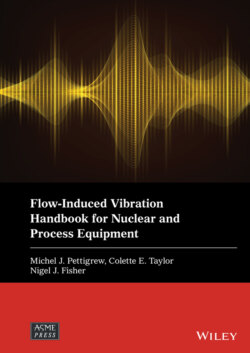Читать книгу Flow-Induced Vibration Handbook for Nuclear and Process Equipment - Группа авторов - Страница 42
2.4.3 Periodic Wake Shedding
ОглавлениеPeriodic wake shedding, or vortex shedding, may be a problem when the shedding frequency coincides with a tube natural frequency. This coincidence may lead to resonance and large vibration amplitudes. Periodic‐wake‐shedding resonance in tube bundles subjected to liquid cross flow was observed in early research by Pettigrew and Gorman (1981).
Periodic‐wake‐shedding resonance may be of concern in liquid cross flow where the flow is relatively uniform. It is not normally a problem at the entrance region of steam generators because the flow is very non‐uniform and quite turbulent. Turbulence may inhibit periodic wake shedding in tube arrays. Periodic wake shedding is generally not a problem in two‐phase flow except at very low void fractions (i.e., εg < 15%) (Pettigrew and Taylor, 1994). Then, the behavior is similar to liquid flow.
Periodic-wake-shedding resonance is usually not a problem in heat exchangers with shell‐side gas flow. The gas density is usually too low to cause significant periodic forces at flow velocities close to resonance. Normal flow velocities in gas heat exchangers are usually much higher than those required for resonance. However, resonance may be possible in high‐pressure components such as MSRs with higher density gas on the shell side. It could also happen for higher modes of vibration with higher frequencies corresponding to higher flow velocities. Thus, periodic‐wake‐shedding resonance cannot always be ignored in gas heat exchangers.
Generally, there is less information on the magnitude of periodic‐wake‐shedding forces in tube bundles than on the frequency of periodic wake shedding, because acoustic resonance in gas‐flow heat exchangers has proven to be a more significant problem in gas‐flow heat exchangers than tube vibration due to vortex shedding.
A recommended formulation for periodic wake shedding is given below. See Chapter 11 for more detail.
Periodic wake shedding is described in terms of a Strouhal number S = fSD/Up, which formulates the wake shedding frequency, fS, and a fluctuating lift coefficient, CL, which is used to estimate the periodic forces, FL, due to wake shedding. Thus:
(2‐35)
Periodic‐wake‐shedding Strouhal number data is summarized in Fig. 2-16 where the Strouhal numbers, St, are defined in terms of the approach velocity U∞. Although there is a lot of scatter in the data, expressions based on Owen’s (1965) theory were proposed to formulate the average values, as shown by the curves in Fig. 2-16. These expressions can easily be transformed to yield Strouhal numbers, S, defined in terms of the pitch velocity. Thus,
(2‐36a)
for normal‐triangular bundles,
(2‐36b)
Fig. 2-16 Strouhal Numbers for Tube Bundles in Liquid Cross Flow: a) Normal Square, b) Rotated Square, c) Normal Triangular, and d) Rotated Triangular.
for rotated‐triangular bundles, and
(2‐36c)
for both normal‐ and rotated‐square bundles.
These expressions give Strouhal numbers between about 0.32 and 0.70 for realistic heat exchanger tube bundles of P/D between 1.23 and 1.57. These Strouhal numbers correspond to dimensionless pitch velocities, Up/fD, between 1.5 and 3.0. Resonance should be assumed possible within this velocity range. In the case of a tube subjected to a non‐uniform velocity, only the fluctuating fluid forces corresponding to the region within the above range of dimensionless velocities need to be considered.
A review of the available data showed that fluctuating forces due to periodic wake shedding depend on several parameters such as bundle configuration, location within the bundle, Reynolds number, turbulence level, fluid density and P/D. At the limit when P/D is large, fluctuating force coefficients should approach those for single cylinders. On the other hand, when P/D is very small the force coefficients are small since the fluid mass associated with the formation of periodic wake or vortices is small as there is little space available within the bundle for large vortices.
The available data for fluctuating force coefficients in single‐ and two‐phase flow is compiled in Fig. 2-17 and Fig. 2-18, respectively. In single‐phase flow, Fig. 2-17 shows that the fluctuating lift coefficient, CL, is very dependent on P/D up to P/D ≈ 2.5. For both single‐ and two‐phase flow within heat exchanger tube bundles of P/D < 1.6, a fluctuating force coefficient of CL = 0.075 rms is recommended to calculate periodic‐wake‐shedding forces.
When resonance is considered possible, the maximum allowable tube vibration amplitude should not exceed 0.02D or 2% of the tube diameter. Below 0.02D, the vibration amplitude is generally not sufficient to correlate periodic wake shedding along the tube, resulting in much lower vibration response. If the vibration response exceeds 0.02D, a fatigue analysis and a fretting‐wear damage calculation should be done, as outlined in Chapter 12.
Fig. 2-17 Fluctuating Force Coefficients for Tube Bundles in Single‐Phase Cross Flow. (Based on Weaver et al. 1987)
Fig. 2-18 Fluctuating Force Coefficients for Tube Bundles in Two‐Phase Cross Flow.
